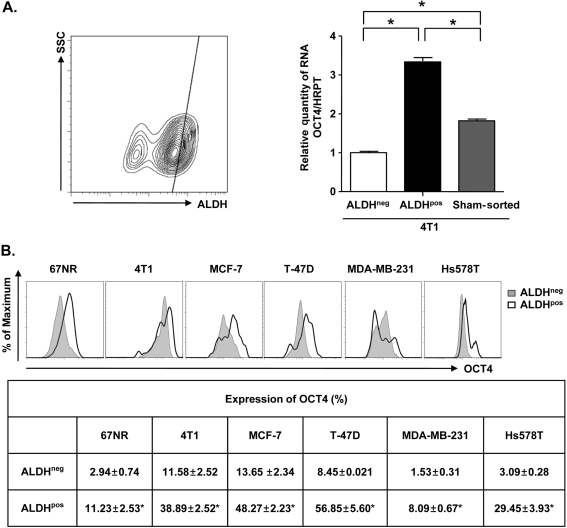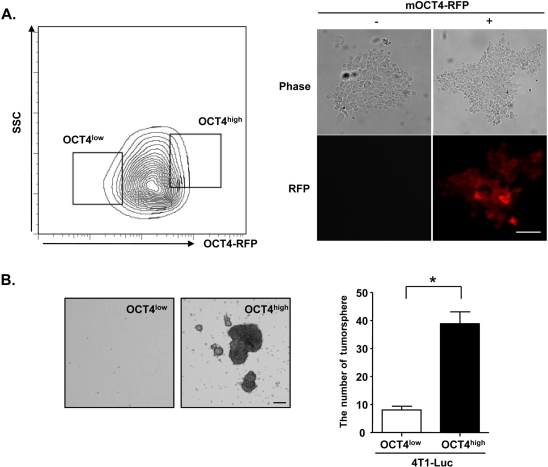Lab Anim Res.
2011 Jun;27(2):147-152. 10.5625/lar.2011.27.2.147.
OCT4 Expression Enhances Features of Cancer Stem Cells in a Mouse Model of Breast Cancer
- Affiliations
-
- 1Laboratory of Tumor Suppressor, Lee Gil Ya Cancer and Diabetes Institute, Gachon University of Medicine and Science, Incheon, Republic of Korea. namjs@gachon.ac.kr
- KMID: 2053664
- DOI: http://doi.org/10.5625/lar.2011.27.2.147
Abstract
- The cancer stem cell (CSC) hypothesis proposes that CSCs are responsible for metastasis and disease recurrence. Therefore, targeting CSCs has the potential to significantly improve outcomes for cancer patients. The OCT4 transcription factor gene is a master gene that plays a key role in the self-renewal and pluripotency of stem cells. In this study, we introduced an OCT4 reporting vector into 4T1 mouse breast cancer cells and sorted OCT4 high and OCT4 low cell populations. We then determined whether OCT4 expression is associated with maintenance and expansion of CSCs. We found that OCT4high 4T1 cells have an increased ability to form tumorsphere and a high expression of stem cell markers such as Sca-1, CD133, CD34, and ALDH1, when compared with OCT4low 4T1 cells. In addition, OCT4high 4T1 cells have greater tumorigenic potential in vivo. These findings suggest that OCT4 expression may be a useful target for stem cell-specific cancer therapy.
Keyword
MeSH Terms
Figure
Reference
-
1. Dean M, Fojo T, Bates S. Tumour stem cells and drug resistance. Nat Rev Cancer. 2005; 5(4):275–284. PMID: 15803154.
Article2. Charafe-Jauffret E, Monville F, Ginestier C, Dontu G, Birnbaum D, Wicha MS. Cancer Stem Cells in Breast: Current Opinion and Future Challenges. Pathobiology. 2008; 75(2):75–84. PMID: 18544962.
Article3. Gangemi R, Paleari L, Orengo AM, Cesario A, Chessa L, Ferrini S, et al. Cancer stem cells: a new paradigm for understanding tumor growth and progression and drug resistance. Curr Med Chem. 2009; 16(14):1688–1703. PMID: 19442140.
Article4. Hansis C, Grifo JA, Krey LC. Oct-4 expression in inner cell mass and trophectoderm of human blastocysts. Mol Hum Reprod. 2000; 6(11):999–1004. PMID: 11044462.
Article5. Burdon T, Smith A, Savatier P. Signalling, cell cycle and pluripotency in embryonic stem cells. Trends Cell Biol. 2002; 12(9):432–438. PMID: 12220864.
Article6. Kim JB, Greber B, Arauzo-Bravo MJ, Meyer J, Park KI, Zaehres H, et al. Direct reprogramming of human neural stem cells by OCT4. Nature. 2009; 461(7264):649–653. PMID: 19718018.
Article7. Chang CC, Shieh GS, Wu P, Lin CC, Shiau AL, Wu CL. Oct-3/4 expression reflects tumor progression and regulates motility of bladder cancer cells. Cancer Res. 2008; 68(15):6281–6291. PMID: 18676852.
Article8. Hu T, Liu S, Breiter DR, Wang F, Tang Y, Sun S. Octamer 4 small interfering RNA results in cancer stem cell-like cell apoptosis. Cancer Res. 2008; 68(16):6533–6540. PMID: 18701476.
Article9. Nam JS, Kang MJ, Suchar AM, Shimamura T, Kohn EA, Michalowska AM, et al. Chemokine (C-C motif) ligand 2 mediates the prometastatic effect of dysadherin in human breast cancer cells. Cancer Res. 2006; 66(14):7176–7184. PMID: 16849564.
Article10. Nam JS, Suchar AM, Kang MJ, Stuelten CH, Tang B, Michalowska AM, et al. Bone sialoprotein mediates the tumor cell-targeted prometastatic activity of transforming growth factor beta in a mouse model of breast cancer. Cancer Res. 2006; 66(12):6327–6335. PMID: 16778210.11. Choi ES, Cho SD, Jeon JG, Cho NP. The Apoptotic Effect of the Hexane Extract of Rheum undulatum L. in Oral Cancer Cells through the Down-regulation of Specificity Protein 1 and Survivin. Lab Anim Res. 2011; 27(1):19–24.12. Dontu G, Abdallah WM, Foley JM, Jackson KW, Clarke MF, Kawamura MJ, et al. In vitro propagation and transcriptional profiling of human mammary stem/progenitor cells. Genes Dev. 2003; 17(10):1253–1270. PMID: 12756227.
Article13. Kim RJ, Kim SR, Roh KJ, Park SB, Park JR, Kang KS, et al. Ras activation contributes to the maintenance and expansion of Sca-1pos cells in a mouse model of breast cancer. Cancer Lett. 2010; 287(2):172–181. PMID: 19586713.
Article14. Ginestier C, Hur MH, Charafe-Jauffret E, Monville F, Dutcher J, Brown M, et al. ALDH1 Is a Marker of Normal and Malignant Human Mammary Stem Cells and a Predictor of Poor Clinical Outcome. Cell Stem Cell. 2007; 1(5):555–567. PMID: 18371393.
Article15. Bao S, Wu Q, McLendon RE, Hao Y, Shi Q, Hjelmeland AB, et al. Glioma stem cells promote radioresistance by preferential activation of the DNA damage response. Nature. 2006; 444(7120):756–760. PMID: 17051156.
Article16. Bonnet D, Dick JE. Human acute myeloid leukemia is organized as a hierarchy that originates from a primitive hematopoietic cell. Nat Med. 1997; 3(7):730–737. PMID: 9212098.
Article17. Welm BE, Tepera SB, Venezia T, Graubert TA, Rosen JM, Goodell MA. Sca-1(pos) cells in the mouse mammary gland represent an enriched progenitor cell population. Dev Biol. 2002; 245(1):42–56. PMID: 11969254.
Article18. Yang ZF, Ho DW, Ng MN, Lau CK, Yu WC, Ngai P, et al. Significance of CD90+ cancer stem cells in human liver cancer. Cancer Cell. 2008; 13(2):153–166. PMID: 18242515.
Article19. Nichols J, Zevnik B, Anastassiadis K, Niwa H, Klewe-Nebenius D, Chambers I, et al. Formation of pluripotent stem cells in the mammalian embryo depends on the POU transcription factor Oct4. Cell. 1998; 95(3):379–391. PMID: 9814708.
Article20. Babaie Y, Herwig R, Greber B, Brink TC, Wruck W, Groth D, et al. Analysis of Oct4-dependent transcriptional networks regulating self-renewal and pluripotency in human embryonic stem cells. Stem Cells. 2007; 25(2):500–510. PMID: 17068183.
Article21. Kuperwasser C, Chavarria T, Wu M, Magrane G, Gray JW, Carey L, et al. Reconstruction of functionally normal and malignant human breast tissues in mice. Proc Natl Acad Sci USA. 2004; 101(14):4966–4971. PMID: 15051869.22. Lelekakis M, Moseley JM, Martin TJ, Hards D, Williams E, Ho P, et al. A novel orthotopic model of breast cancer metastasis to bone. Clin Exp Metastasis. 1999; 17(2):163–170. PMID: 10411109.23. Boiani M, Scholer HR. Regulatory networks in embryo-derived pluripotent stem cells. Nat Rev Mol Cell Biol. 2005; 6(11):872–884. PMID: 16227977.
Article
- Full Text Links
- Actions
-
Cited
- CITED
-
- Close
- Share
- Similar articles
-
- The Role and Specific Mechanism of OCT4 in Cancer Stem Cells: A Review
- Expression of CD133, CD44, CK7, and OCT4 in Animal Cancers
- New Findings on Breast Cancer Stem Cells: A Review
- Inhibitor of DNA-binding 4 contributes to the maintenance and expansion of cancer stem cells in 4T1 mouse mammary cancer cell line
- Invited Commentary on: Can CD44+/CD24- Tumor Stem Cells Be Used to Determine the Extent of Breast Cancer Invasion Following Neoadjuvant Chemotherapy?





